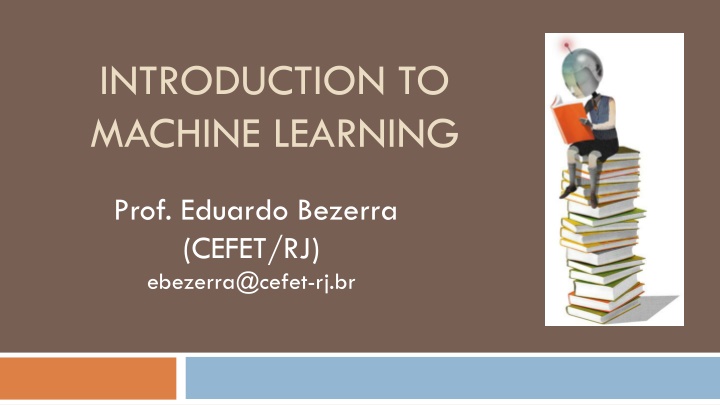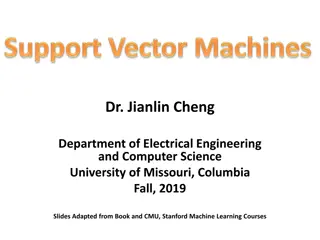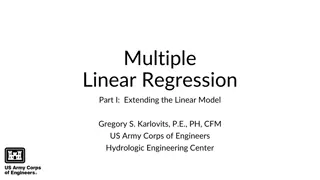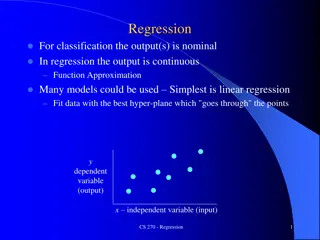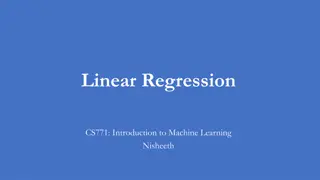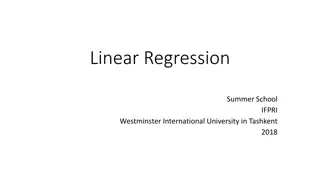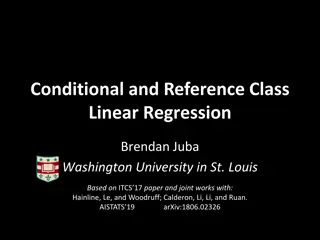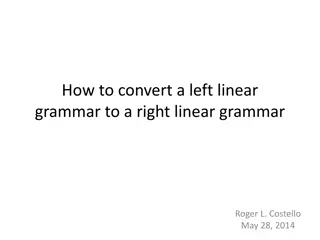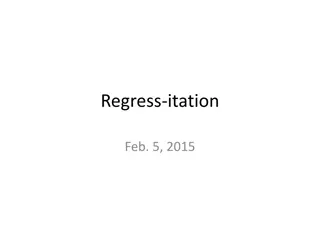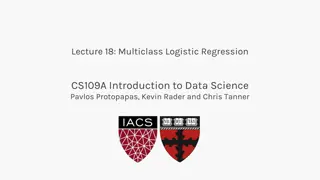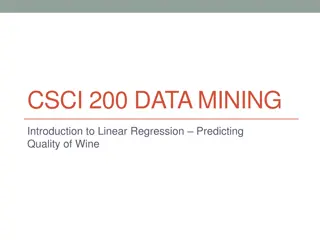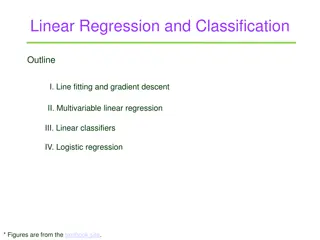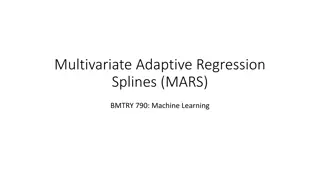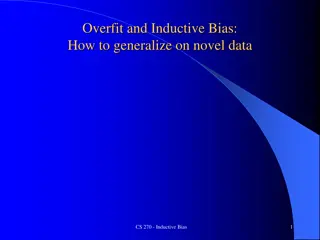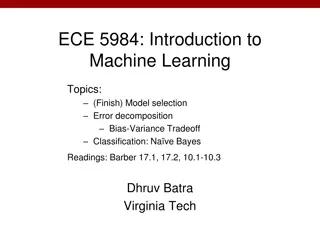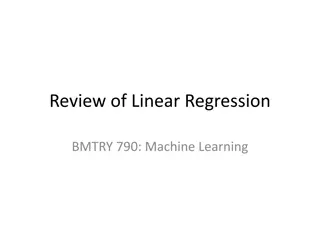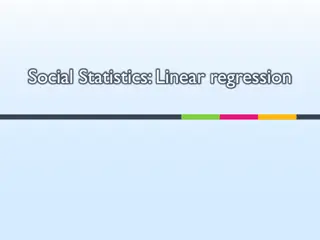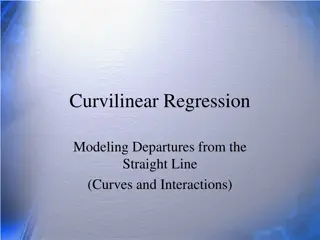Introduction to Linear Regression in Machine Learning
Explore the fundamentals of linear regression in machine learning through an overview of model representation, evaluation, optimization, and practical considerations such as feature scaling and engineering. Dive into the notation, components, hypothesis representation, model evaluation with cost functions, and parameter determination in the context of linear regression. Understand the importance of Mean Squared Error (MSE) as a measure for evaluating hypotheses in linear regression models.
Download Presentation

Please find below an Image/Link to download the presentation.
The content on the website is provided AS IS for your information and personal use only. It may not be sold, licensed, or shared on other websites without obtaining consent from the author.If you encounter any issues during the download, it is possible that the publisher has removed the file from their server.
You are allowed to download the files provided on this website for personal or commercial use, subject to the condition that they are used lawfully. All files are the property of their respective owners.
The content on the website is provided AS IS for your information and personal use only. It may not be sold, licensed, or shared on other websites without obtaining consent from the author.
E N D
Presentation Transcript
INTRODUCTION TO MACHINE LEARNING Prof. Eduardo Bezerra (CEFET/RJ) ebezerra@cefet-rj.br
Overview 3 Introduction Univariate Linear Regression Model representation Model evaluation Model optimization Multivariate Linear Regression Practical issues: feature scaling & feature engineering Polynomial Regression
Notation 6 m = amount of training examples x = a vector of features y = target value (scalar)
Components 7 In order to apply any ML algorithm (including linear regression), we need to define three components: Model representation Model evaluation Model optimization
Representation (univariate case) 9 A hypothesis is a function that maps from x's to y's. How can a hypothesis be represented in the univariate linear regression setting?
Model parameters 11 Once... we have the training set in hand, and we define the form (of representation) of the hypothesis ... ... how do we determine the parameters of the model? Idea: choose the combination of parameters such that the hypothesis produces values close to the values y contained in the training set.
Mean Squared Error (MSE) measure 12 In linear regression, hypothesis are evaluated through the MSE measure.
Gradient Descent algorithm 15 Given a cost function J, we want to determine the combination of parameter values that minimizes J. Optimization procedure: Initialize the parameter vector Iterate: update parameter vector with the purpose of finding the minimum value of J
Gradient Descent algorithm 16 Updating must be simultaneous! is a small positive constante, the learning rate (more later)
Learning rate 18 (learning rate): hyperparameter that needs to be carefully chosen... How? Try multiple values and pick the best one model selection (more latter).
GD for Linear Regression (univariate case) 19 Gradient Descent Linear Regression Model
Multiple features (n=2) 22 Source: https://gerardnico.com
Notation 24 : i-th training example. : j-th feature value in the i-th example; : amount of features
Model representation 25 Univariate case (n=1): Multivariate case (n > 1):
Gradient Descent (n 1) 27 Reminder:
Practical issue: feature scaling 28 Here we study the effect of the existence of different scales on the dependent variables.
Feature scaling 29 Since the range of values of raw data varies widely, [ ], objective functions will not work properly without normalization. [ ] If one of the features has a broad range of values, the distance will be governed by this particular feature. Therefore, the range of all features should be normalized so that each feature contributes approximately proportionately to the final distance. Another reason why feature scaling is applied is that gradient descent converges much faster with feature scaling than without it. --Wikipedia Scaled features make ML algorithms converge better and faster.
Some feature scaling techniques 31 Min-max scaling z-score Scaling to unit length
Scaling techniques - example 32 Source: http://sebastianraschka.com/Articles/2014_about_feature_scaling.html
Practical issue: feature engineering 33 Here we study techniques to create new features.
Feature engineering 34 In ML, we are not limited to using only the original features for training a model. Depending on the knowledge we have of a particular dataset, we can combine the original features to create new ones. This can lead to a better predictive model.
Feature engineering 35 The algorithms we used are very standard for Kagglers. [ ] We spent most of our efforts in feature engineering. [...] We were also very careful to discard features likely to expose us to the risk of overfitting our model. Xavier Conort, "Q&A with Xavier Conort some machine learning projects succeed and some fail. What makes the difference? Easily the most important factor is the features used. Pedro Domingos, "A Few Useful Things to Know about Machine Learning" Coming up with features is difficult, time-consuming, requires expert knowledge. "Applied machine learning" is basically feature engineering. Andrew Ng, Machine Learning and AI via Brain simulations
Polynomial regression 37 Here we study how to get approximations for non-linear functions.
Polynomial regression 38 A method to find a hypothesis that corresponds to a polynomial (quadratic, cubic, ...). Related to the idea of features engineering. It allows to use the linear regression machinery to find hypotheses for more complicated functions.
Polynomial regression - example (cont.) 41 The definition of adequate features involves both insight and knowledge of the problem domain.
Polynomial regression vsfeature scaling 42 Scaling features is even more important in the context of polynomial regression.
